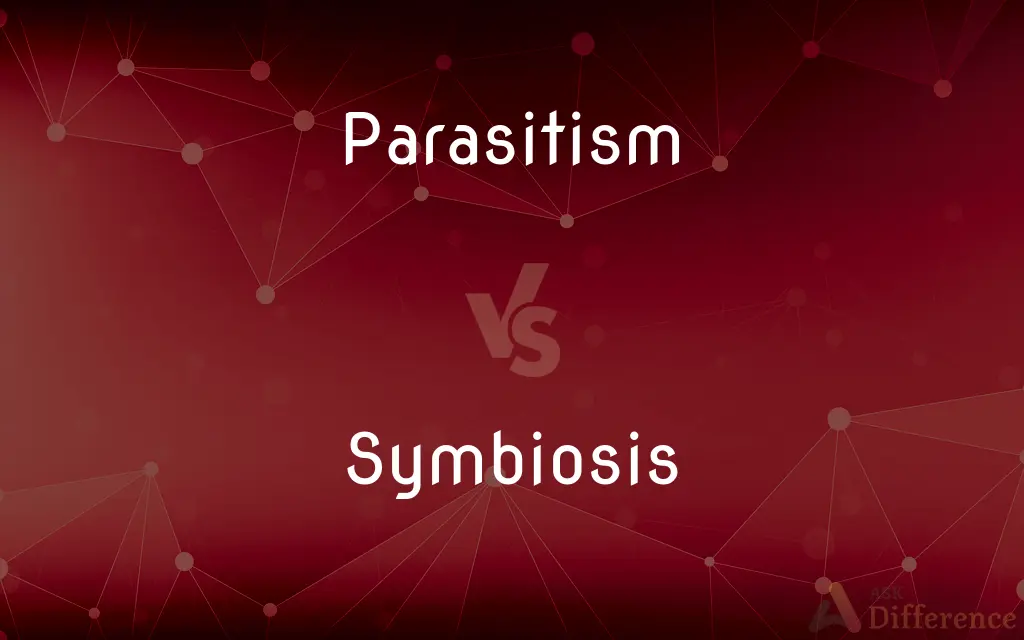Parasitism vs. Symbiosis — What's the Difference?
By Tayyaba Rehman — Published on January 15, 2024
Parasitism is a relationship where one organism benefits at the expense of another, while symbiosis refers to any close and long-term biological interaction between two different organisms, which may be mutualistic, commensal, or parasitic.

Difference Between Parasitism and Symbiosis
Table of Contents
ADVERTISEMENT
Key Differences
Parasitism is a type of symbiotic relationship where the parasite benefits while causing harm to the host. In contrast, symbiosis covers a broader range of interactions including mutualism (both benefit), commensalism (one benefits, the other is unaffected), and parasitism.
In parasitism, the relationship is often detrimental to the host's health and can lead to various diseases. Symbiotic relationships like mutualism involve both organisms benefiting, such as in the relationship between bees and flowers.
Parasites typically rely on their host for nourishment or other needs, often resulting in a one-sided relationship. Symbiosis can involve more complex interactions, including shared habitats, resources, or mutual defense.
Parasitic relationships are usually more specific, with parasites often evolving to live with a particular host. Symbiotic relationships can be more general or specialized, depending on the organisms involved and the nature of their interaction.
Examples of parasitism include tapeworms in mammals and fleas on dogs. Examples of symbiosis include lichen (a partnership between a fungus and an alga) and the gut flora in humans.
ADVERTISEMENT
Comparison Chart
Relationship Type
One organism benefits, the other is harmed
Includes mutualism, commensalism, and parasitism
Effect on Organisms
Detrimental to the host
Can be beneficial, neutral, or harmful
Dependency
Parasite relies on the host
Varies, can be mutual or one-sided
Specificity
Often specific to particular hosts
Can range from general to highly specific
Examples
Tapeworms, fleas
Lichen, bees and flowers
Compare with Definitions
Parasitism
Often detrimental to the host's health.
The parasitic relationship between ticks and dogs can lead to diseases.
Symbiosis
Affects the evolution and behavior of the organisms involved.
Symbiosis between fungi and algae forms lichens, a new entity altogether.
Parasitism
A relationship where one organism benefits at the expense of another.
Mosquitoes feeding on human blood is an example of parasitism.
Symbiosis
Can involve shared resources or habitats.
The gut flora in humans is a symbiotic relationship crucial for digestion.
Parasitism
Parasites are typically smaller than their hosts.
Lice, as parasites, are much smaller than their human hosts.
Symbiosis
A long-term interaction between two different species.
The symbiotic relationship between clownfish and sea anemones benefits both.
Parasitism
Can involve various forms of dependence.
Mistletoe extracting nutrients from trees is a form of parasitism.
Symbiosis
Includes mutualistic, commensal, and parasitic relationships.
In coral reefs, symbiosis is observed in multiple forms among various species.
Parasitism
Parasite derives nourishment from its host.
Tapeworms living in the intestines of mammals are parasites.
Symbiosis
Symbiotic relationships vary in their level of intimacy and dependency.
The symbiosis between bees and flowers involves pollination and nectar exchange.
Parasitism
A relationship between two organisms of different species in which one is a parasite and the other is a host.
Symbiosis
(Biology) A close, prolonged association between two or more different organisms of different species that may, but does not necessarily, benefit each member.
Parasitism
The characteristic behavior or mode of existence of a parasite or parasitic population.
Symbiosis
A relationship of mutual benefit or dependence.
Parasitism
Parasitosis.
Symbiosis
A relationship of mutual benefit, especially among different species.
Parasitism
(ecology) Interaction between two organisms, in which one organism (the parasite) benefits and the other (the host) is harmed.
Symbiosis
(ecology) A close, prolonged association between two or more organisms of different species that normally benefits both members. An interspecies cooperation.
Parasitism
(figuratively) A similar interaction between people.
We accused her of parasitism in taking his hard-earned money for new dresses.
Symbiosis
(biology) A close, prolonged association between two or more organisms of different species, regardless of benefit to the members.
Parasitism
The state or behavior of a parasite; the act of a parasite.
Symbiosis
The state of people of different types, races, cultures, communities, etc., living together.
Parasitism
The state of being parasitic.
Symbiosis
The occurrence of two different or opposing things in the same time and place.
Parasitism
The relation between two different kinds of organisms in which one receives benefits from the other by causing damage to it (usually not fatal damage)
Symbiosis
The living together in more or less imitative association or even close union of two dissimilar organisms. In a broad sense the term includes parasitism, or antagonistic symbiosis or antipathetic symbiosis, in which the association is disadvantageous or destructive to one of the organisms, but ordinarily it is used of cases where the association is advantageous, or often necessary, to one or both, and not harmful to either. When there is bodily union (in extreme cases so close that the two form practically a single body, as in the union of algæ and fungi to form lichens, and in the inclusion of algæ in radiolarians) it is called conjunctive symbiosis; if there is no actual union of the organisms (as in the association of ants with myrmecophytes), disjunctive symbiosis.
Symbiosis
The relation between two different species of organisms that are interdependent; each gains benefits from the other
Common Curiosities
What are examples of parasitic organisms?
Tapeworms, fleas, and mosquitoes.
What is parasitism?
A relationship where one organism benefits at the expense of another.
Can a symbiotic relationship be harmful?
Yes, in the case of parasitism.
How does symbiosis impact ecosystems?
It plays a crucial role in maintaining ecosystem balance.
How does symbiosis differ from parasitism?
Symbiosis includes various forms of close biological interactions, including parasitism.
How do parasites affect their hosts?
They often cause harm by feeding on or within the host.
Do all symbiotic relationships involve dependence?
Yes, but the degree of dependence varies.
What is an example of a mutualistic symbiotic relationship?
The relationship between bees and flowering plants.
Is commensalism beneficial to both organisms?
No, one benefits while the other is unaffected.
Is mutualism a type of symbiosis?
Yes, it's a mutually beneficial symbiotic relationship.
Can humans have parasitic relationships with other organisms?
Yes, with organisms like tapeworms or lice.
Are all symbiotic relationships permanent?
Not always; some are transient or seasonal.
Can a parasitic relationship evolve into mutualism?
Rarely, but evolutionary changes can alter the nature of interactions.
Are symbiotic relationships always between different species?
Yes, symbiosis involves interactions between different species.
Can symbiotic relationships change over time?
Yes, environmental and evolutionary factors can alter these relationships.
Share Your Discovery

Previous Comparison
Ponzi Scheme vs. Social Security
Next Comparison
Ceramic Capacitor vs. Electrolytic CapacitorAuthor Spotlight
Written by
Tayyaba RehmanTayyaba Rehman is a distinguished writer, currently serving as a primary contributor to askdifference.com. As a researcher in semantics and etymology, Tayyaba's passion for the complexity of languages and their distinctions has found a perfect home on the platform. Tayyaba delves into the intricacies of language, distinguishing between commonly confused words and phrases, thereby providing clarity for readers worldwide.












































